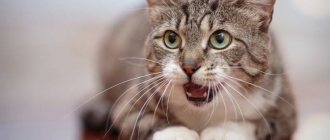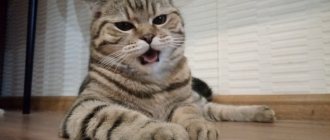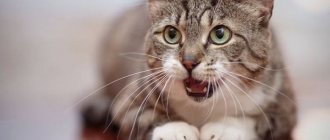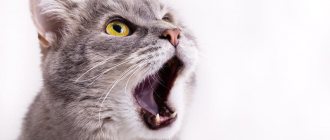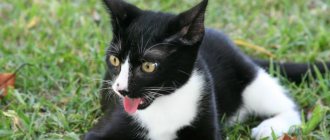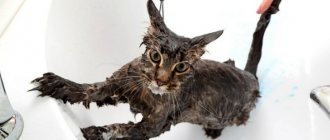13567Administration
If the cat is breathing heavily and wheezing, then this indicates a serious illness. It is necessary to pay attention to the characteristics of the symptoms. For example, when a cat breathes normally, the animal's chest rises and falls. In this case, the process occurs calmly, without jerks or convulsive movements.
However, if the cat begins to breathe from the stomach and sides, this means a disruption in the functioning of the respiratory tract. It is painful for the animal to exhale and inhale, as it does in a normal state. An even more alarming syndrome is when wheezing is added to the symptoms listed above.
© shutterstock
Causes of wheezing with heavy breathing
This is noisy bubbling breathing. It can occasionally be caused by a cold, and also accompanies most diseases of the respiratory system. A cat often wheezes for the following reasons :
- foaming of accumulated liquid (blood, trans- or exudate);
- the gaps in the respiratory tract narrow.
When the animal loses its voice, it wheezes for a long time. This indicates a violation of the vocal cords, their incomplete closure. The animal will wheeze until they are fully recovered. This phenomenon occurs when mucous fluid accumulates in crevices or with laryngitis.
Changes in a cat's breathing may be a consequence of obesity. In this case, even after little physical activity the animal breathes heavily. Sudden wheezing may indicate that the cat has swallowed a foreign body that is stuck in the throat. You can't try to pull it out on your own. Why can't pet owners do this? Without qualified help, the object can be pushed even further and the animal will die.
Symptoms and diagnosis
Depending on the causes of the disease. In addition to cough, the following additional symptoms develop:
- dyspnea;
- refusal to eat;
- salivation;
- elevated temperature.
The veterinarian examines the animal, identifies clinical symptoms, collects anamnesis, and takes blood samples for general analysis and biochemistry. If necessary, additional diagnostic studies are carried out:
- stool analysis;
- study of tracheal washings;
- X-ray of the chest cavity.
The doctor deciphers the research results and develops a treatment strategy.
Types of wheezing
Wheezing is a combination of sounds and noises. Each disease has its own variants. Wheezing can be :
- with a whistle;
- wet;
- crepitant;
- dry.
© shutterstock
If moist wheezing is heard, the cat is suffering from mucus accumulated in the bronchi. Sputum is formed in large quantities against the background of inflammation and colds that affect the broncho-tree. The inhaled air seeps through the mucus in the form of bubbles, which then burst. As a result, the cat wheezes when he breathes. This combination of sounds refers to the wet version. In this case, wheezing has several varieties :
- Fine bubbles, when small balloons formed by phlegm collapse. They appear with bronchitis, pneumonia and pulmonary infarction.
- Medium bubbly - like the sound of air being blown through a straw. Such wheezing appears during bronchitis, accompanied by excessive mucus production, pneumosclerosis, or pulmonary fibrotic changes.
- Large bubbles can be heard without a medical device. Wheezing appears due to the accumulation of exudate in the lungs. This occurs due to swelling of the organ or with a weak cough.
Dry, heavy breathing with wheezing may be the result of obstruction due to narrowing of the bronchi. Also, the reason may be an allergic reaction or compression of the airways by a neoplasm. It is difficult for air to penetrate through narrow gaps, which creates a certain noise. Then it develops into a wheezing wheeze as it moves along the unevenly narrowed bronchi.
If they also contain viscous mucus, then membranes are created that block the path of air. As a result, breathing takes on a buzzing sound. It is very difficult for air to penetrate through the narrowed and partially covered lumen.
Prevention measures
To prevent your cat from wheezing, you need to regularly monitor his health and regularly visit the veterinarian. Timely deworming and vaccination help reduce the likelihood of difficulty breathing. In most cases, wheezing is recorded due to disorders of the respiratory tract. To prevent such diseases, you should not allow hypothermia and give your pet cold food and water. It is important to eliminate all possible allergens and monitor the animal so that it does not ingest any foreign objects. If you have difficulty breathing or other alarming symptoms, you should not self-medicate, but should immediately contact a veterinarian so that your pet does not die.
The appearance of wheezing due to illness
The causes of wheezing are divided into 2 groups. Each of them has its own characteristics. Symptoms can appear in both a kitten and an adult.
Pulmonary
The pulmonary group of causes is caused by diseases of the respiratory system. The appearance of wheezing can be a consequence of inflammation, including an allergic nature. Sometimes the airways become injured by foreign bodies accidentally entering them.
© shutterstock
In this case, they get stuck in the larynx, pharynx, bronchi or trachea. This interferes with normal breathing, it becomes heavier and more difficult. The cat begins to wheeze, sniffle and cough. Foamy fluid is discharged from the nostrils, sometimes with blood clots. The cat does not drink or eat and can easily suffocate.
ARVI or influenza is not scary for these animals; they do not get sick from them. However, viral infections may well be picked up. For example, a cat wheezes and sneezes when she gets sick :
- Rhinotracheitis, calcivirosis. Against their background, the animal appears to be breathing heavily. Both diseases are viral and are very dangerous for cats. Pathologies affect the mucous surfaces of the intestines and respiratory system. At the same time, this is accompanied by diarrhea (sometimes with severe dehydration), cough, high fever and wheezing. With rhinotracheitis, additional purulent mucus is released from the nose and eyes, and with calcivirosis - ulcers on the tongue and mucous membranes of the eyes.
- With asthma, a cat huddles to the floor, coughs, wheezes and stretches its neck. If the disease is severe, severe shortness of breath, wheezing, and even suffocation of the animal appear. Owners confuse these symptoms, believing that the cat simply choked. However, if it is asthma, then the attacks will become more frequent. However, there is no guarantee that the animal will not suffocate without the help of a veterinarian.
- Pneumonia can have a different nature - fungal, bacterial or viral. First, the cat begins to cough violently, as if barking. It “scratches” the respiratory tract, the animal’s temperature rises, and wet wheezing sounds are heard.
- Brachycephalic syndrome is accompanied by the proliferation of palatal tissues and narrowing of the nasal passages. As a result, the cat begins to wheeze and wheeze. During sleep, the animal's mouth is constantly open. At the same time, the cat eats normally and remains active.
- With tracheal collapse, the initial stage does not bother the animal. With strong emotional outbursts, the cat begins to cough, then wheeze, and breathing becomes heavy. Often the animal even loses consciousness.
- Helmitoses are parasites. Their migration causes wheezing, similar to that heard in bronchial asthma. Most often, cats are diagnosed with dirofilariasis or aleurostrongylosis.
- Pneumo- and hydrothorax occur after rupture of the lungs. The most common cause is tumors and injuries. The cat is breathing heavily, with wheezing. The animal sits with its mouth wide open.
- Laryngospasm, swelling of the larynx, appears when a cat is poisoned by household chemicals. Also, wheezing can occur due to an allergic reaction after inhaling smoke, strong aromas, or dust. In these cases, the animal breathes with difficulty, whistling.
Light wheezing and heavy hissing can appear due to congenital pathologies - with elongation of the palate, polyps, narrowing of the nasal passages. Symptoms worsen after any physical activity.
Extrapulmonary
The extrapulmonary group of causes is caused by a disorder in the functioning of internal organs and systems that are not associated with the respiratory system. Diseases :
- Pulmonary edema is caused by various diseases of internal organs and their inflammation. At the same time, the cat breathes with great difficulty, with wheezing, the sides become very swollen, and pinkish foam appears from the nose.
- A diaphragmatic hernia is very similar in symptoms to asthma. The animal is also breathing heavily and hoarsely.
- The same symptoms are characteristic of heart failure, but in this case the animal does not cough. Myocardosis and carditis, and arrhythmia lead to disruption of the respiratory system.
© shutterstock
Often the cause of wheezing and heavy breathing is kidney failure. It leads to pulmonary edema. At the same time, the animal’s sides swell and a severe cough appears.
First aid
If the animal suddenly stops breathing, it is necessary to perform chest compressions and artificial respiration. Place the pet so that the neck is an even continuation of the spine.
- Clean the mouth from excess mucus, saliva and foreign objects and close it.
- The palms form a tube to inhale air into the cat’s nose; the frequency of inhalations should depend on the size of the animal. Up to 20 breaths should be taken within one minute. If the kitten is small, then the frequency must be reduced, otherwise there is a high risk of damage to the pet’s lungs due to the large volume of air.
- If rhythm is completely lost, you need to do an indirect massage. Place the palm of one hand over your chest so that your thumb moves away from the rest. Rhythmically clench and unclench your fingers 5 times - exhale into your pet’s nose. In this case, you should check your pulse every 2 minutes.
Tags
if a cat coughs a panting cat in a cat licking fur, this is a cat before If a cat is not an adult cat can If a cat is in a hurry about a dog about a dog Dog breeds Dog health Dog nutrition Dog training Dog health behind a dog Why is a dog afraid of Dogs in cats. cat deaths occur in cats and Cat breeds Cat health Cat nutrition Cat behavior Health cats in cats and in cats and
dogbreedrodentsarticlerespiratoryservicesopen questioncontentsurgeonanswervaccinationbirddepartment
A cat breathes heavily from its belly - when is it normal?
If the lack of oxygen is temporary, then there is no need to worry. The respiratory rate subsides and the cat breathes through its nose again.
The phenomenon develops due to the following reasons:
- heat;
- estrus;
- lambing;
- lactation;
- excessive physical activity;
- fright;
- motion sickness in a car.
Why does a cat cough and sneeze? Let’s look at the main reasons
The reasons that a cat sneezes are no less than the reasons for coughing. Treatment also depends on the cause of the disease. So, if it is a fungus, then drugs are used against it. If a foreign body is stuck in the nose or trachea, the doctor must remove it. And so on for each disease.
Here we will look at the main causes and methods of treating them, however, the information is for informational purposes only and it is strictly not recommended to treat your pet on your own.
Upper respiratory tract infections in cats
It is upper respiratory tract infections in cats that become the most common cause of sneezing in cats. There are different types of infections: fungus, bacteria and viruses. The symptoms are approximately the same:
- Kitten sneezes
- Coughs often
- His nose is wet
- Eyes with tears
Allergies in cats
As already mentioned, cats suffer from allergies no less than people. The reasons are the same as for people: dust, strong smoke from cigarettes or hookahs, pollen and flowering, various powders, new tray fillers, the smell of food, air fresheners, etc. In such cases, the cat rubs its nose on the surface, as well as with its paws. A cat sneezes only when it is in an allergenic environment; its nose also becomes wet and a runny nose appears. The pet wants to quickly run away from the place where the attacks began.
If you are allergic only to the litter for the tray, then you just need to change it and the allergy will go away, you don’t need to do anything else. If some allergen gets stuck in the pathways and causes discomfort for a long time, you need to consult a doctor for help. It is also worth noting that the exacerbation begins during flowering periods in the spring and sometimes in the fall, so it is enough just to survive short periods of time and suffer a sneeze, but then it will all end and the cat will feel good.
Asthma in cats
Cats also have asthma. A few words have already been said about it, but in some cases the pet coughs, and in others it sneezes. They are treated approximately the same. The cause of the disease is a long interaction with the allergen, which caused sneezing and now continues to do so on a constant and almost chronic basis. They are often treated with warm steam, which the pet inhales. This helps clear the bronchi of excess.
Heartworms in cats
As you know, mosquitoes are carriers of bacteria and diseases; just remember malaria in Africa. However, not everyone knows that mosquitoes can infect a cat with a simple bite. Microscopic larvae enter the body through the insect's proboscis. Through blood vessels and pathways they enter the heart, or more precisely, into its right chambers. The nearby pulmonary and cardiac arteries are affected, the worms become clogged and make breathing difficult, causing the pet to sneeze. If he sneezes frequently, the arteries become clogged and sometimes a heart attack occurs. The main symptoms here are the cat's sneezing and coughing.
Only a veterinarian who has already encountered a similar problem should treat a pet in such a situation. You can’t ignore it and you also can’t advise anything, because the case is serious and requires equally serious intervention from a specialist. It is better, of course, to carry out preventive procedures to avoid infection in principle.
Dental problems in cats
Sometimes it happens. Yes, this is rare, but if there are any problems with the teeth (smell from the mouth, suppuration, gum disease). The infection that struck and caused these causes also reaches the respiratory tract, which leads to sneezing. This happens to kittens that are still weak and their immunity is susceptible to attack.
Treatment in clinical and home settings: which therapy is preferable
For diseases of the respiratory system, cat treatment can be used both clinically and at home. Note that only the simplest operations can be performed at home, and in case of serious illnesses such treatment is completely contraindicated.
The owner can do the following independently:
- Give antibiotics.
- Give bronchodilators and mucolytics.
In other cases, treatment can only be carried out in a clinical setting:
- For cancer, foreign bodies and tracheal collapse, surgery is indicated. The same goes for all serious chest injuries.
- For pneumonia and bronchitis, complex broad-spectrum antibiotics are prescribed. In order for the treatment to be effective, pre-seeding is done on nutrient media and the type of pathogen is accurately determined.
- Asthma attacks are treated with powerful antispasmodics and bronchodilators. The veterinarian’s task is to select the minimum effective dose, since the animal will have to “sit” on these drugs for the rest of its life.
Diseases of other body systems that cause hoarse breathing
Respiratory wheezing can also be observed with other chronic or congenital pathologies of organs and body systems in a cat:
- cardiovascular diseases and heart failure;
- diaphragmatic hernia;
- kidney failure, which can cause pulmonary edema due to fluid accumulation;
- genetic malformations of the respiratory system: brachycephalic syndrome - in which there is a narrowing of the nasal passage, elongation and thickening of the soft palate; collapse of the trachea - when there is deformation of this organ, which is accompanied by loss of muscle elasticity and narrowing of the respiratory lumen.
Feline viral rhinotracheitis
An infectious disease that affects not only the respiratory system, but also the eyes. It is one of the most important diseases to consider when caring for a cat.
Symptoms of rhinotracheitis include:
- purulent discharge from the eyes;
- runny nose and cough;
- wheezing and sneezing;
- temperature increase;
- lack of appetite;
- dyspnea;
- mouth ulcers;
- pain when swallowing;
- open mouth breathing
- general weakness.
The cat stops eating and drinking, which causes weakness and dehydration. The eye problem leads to corneal ulcers and blindness. As soon as viral rhinotracheitis in cats is suspected, you should consult a veterinarian. The disease is mainly caused by the herpes virus and calicivirus infection. Feline herpes causes severe illness, especially in young cats, and is a major threat to kittens.
To treat rhinotracheitis, your veterinarian will prescribe antibiotics, injections, and painkillers. Since a weakened immune system causes loss of appetite, it is advisable to find ways to encourage your cat to eat.
There will be no complete recovery. Symptoms of rhinotracheitis appear due to stress, weakened immunity, poor living conditions, and contact with a sick animal.
